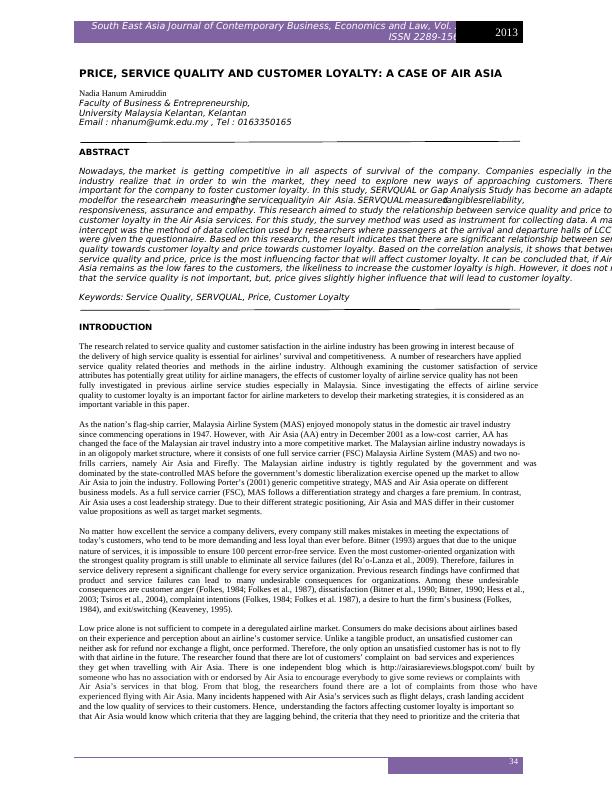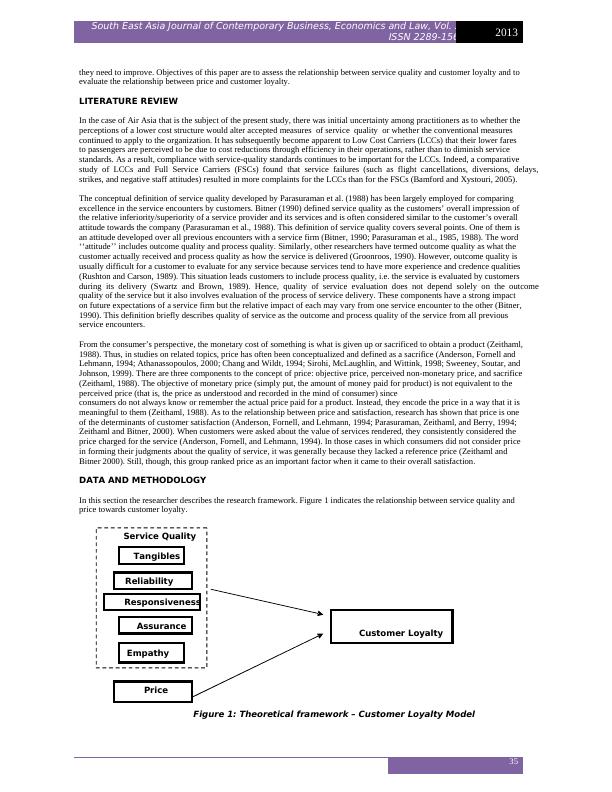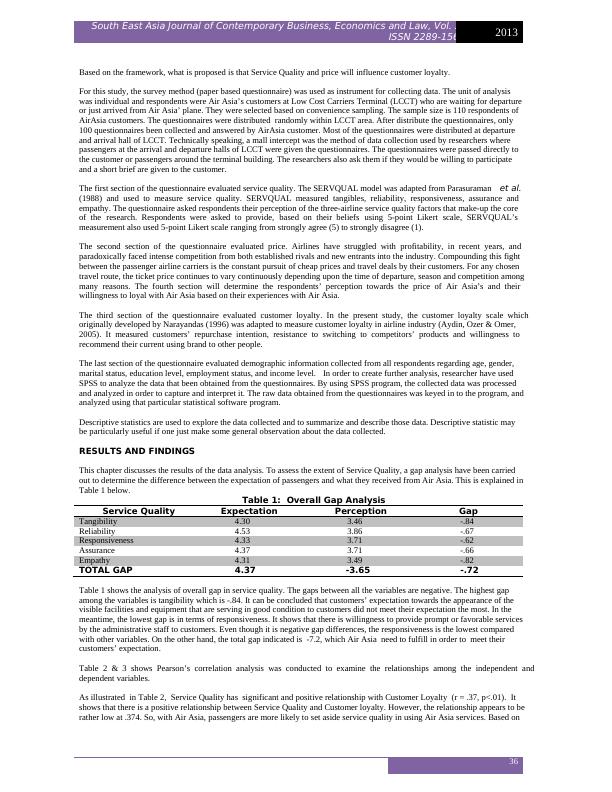South East Asian Journal of Contemporary Business, Economics and Law
7 Pages6132 Words102 Views
Added on 2021-07-07
South East Asian Journal of Contemporary Business, Economics and Law
Added on 2021-07-07
ShareRelated Documents
South East Asia Journal of Contemporary Business, Economics and Law, Vol. 2, Issue 1 (June) ISSN 2289-15602013 34 PRICE, SERVICE QUALITY AND CUSTOMER LOYALTY: A CASE OF AIR ASIA Nadia Hanum Amiruddin Faculty of Business & Entrepreneurship, University Malaysia Kelantan, Kelantan Email : nhanum@umk.edu.my , Tel : 0163350165 ABSTRACT Nowadays, the market is getting competitive in all aspects of survival of the company. Companies especially in the service industry realize that in order to win the market, they need to explore new ways of approaching customers. Therefore, it is important for the company to foster customer loyalty. In this study, SERVQUAL or Gap Analysis Study has become an adapted model for the researcher in measuring the service quality in Air Asia. SERVQUAL measured tangibles, reliability, responsiveness, assurance and empathy. This research aimed to study the relationship between service quality and price towards customer loyalty in the Air Asia services. For this study, the survey method was used as instrument for collecting data. A mall intercept was the method of data collection used by researchers where passengers at the arrival and departure halls of LCCT were given the questionnaire. Based on this research, the result indicates that there are significant relationship between service quality towards customer loyalty and price towards customer loyalty. Based on the correlation analysis, it shows that between service quality and price, price is the most influencing factor that will affect customer loyalty. It can be concluded that, if Air Asia remains as the low fares to the customers, the likeliness to increase the customer loyalty is high. However, it does not mean that the service quality is not important, but, price gives slightly higher influence that will lead to customer loyalty. Keywords: Service Quality, SERVQUAL, Price, Customer Loyalty INTRODUCTION The research related to service quality and customer satisfaction in the airline industry has been growing in interest because of the delivery of high service quality is essential for airlines’ survival and competitiveness. A number of researchers have applied service quality related theories and methods in the airline industry. Although examining the customer satisfaction of service attributes has potentially great utility for airline managers, the effects of customer loyalty of airline service quality has not been fully investigated in previous airline service studies especially in Malaysia. Since investigating the effects of airline service quality to customer loyalty is an important factor for airline marketers to develop their marketing strategies, it is considered as an important variable in this paper. As the nation’s flag-ship carrier, Malaysia Airline System (MAS) enjoyed monopoly status in the domestic air travel industry since commencing operations in 1947. However, with Air Asia (AA) entry in December 2001 as a low-cost carrier, AA has changed the face of the Malaysian air travel industry into a more competitive market. The Malaysian airline industry nowadays is in an oligopoly market structure, where it consists of one full service carrier (FSC) Malaysia Airline System (MAS) and two no-frills carriers, namely Air Asia and Firefly. The Malaysian airline industry is tightly regulated by the government and was dominated by the state-controlled MAS before the government’s domestic liberalization exercise opened up the market to allow Air Asia to join the industry. Following Porter’s (2001) generic competitive strategy, MAS and Air Asia operate on different business models. As a full service carrier (FSC), MAS follows a differentiation strategy and charges a fare premium. In contrast, Air Asia uses a cost leadership strategy. Due to their different strategic positioning, Air Asia and MAS differ in their customer value propositions as well as target market segments. No matter how excellent the service a company delivers, every company still makes mistakes in meeting the expectations of today’s customers, who tend to be more demanding and less loyal than ever before. Bitner (1993) argues that due to the unique nature of services, it is impossible to ensure 100 percent error-free service. Even the most customer-oriented organization with the strongest quality program is still unable to eliminate all service failures (del Rı ́o-Lanza et al., 2009). Therefore, failures in service delivery represent a significant challenge for every service organization. Previous research findings have confirmed that product and service failures can lead to many undesirable consequences for organizations. Among these undesirable consequences are customer anger (Folkes, 1984; Folkes et al., 1987), dissatisfaction (Bitner et al., 1990; Bitner, 1990; Hess et al., 2003; Tsiros et al., 2004), complaint intentions (Folkes, 1984; Folkes et al. 1987), a desire to hurt the firm’s business (Folkes, 1984), and exit/switching (Keaveney, 1995). Low price alone is not sufficient to compete in a deregulated airline market. Consumers do make decisions about airlines based on their experience and perception about an airline’s customer service. Unlike a tangible product, an unsatisfied customer can neither ask for refund nor exchange a flight, once performed. Therefore, the only option an unsatisfied customer has is not to fly with that airline in the future. The researcher found that there are lot of customers’ complaint on bad services and experiences they get when travelling with Air Asia. There is one independent blog which is http://airasiareviews.blogspot.com/ built by someone who has no association with or endorsed by Air Asia to encourage everybody to give some reviews or complaints with Air Asia’s services in that blog. From that blog, the researchers found there are a lot of complaints from those who have experienced flying with Air Asia. Many incidents happened with Air Asia’s services such as flight delays, crash landing accident and the low quality of services to their customers. Hence, understanding the factors affecting customer loyalty is important so that Air Asia would know which criteria that they are lagging behind, the criteria that they need to prioritize and the criteria that

South East Asia Journal of Contemporary Business, Economics and Law, Vol. 2, Issue 1 (June) ISSN 2289-15602013 35 they need to improve. Objectives of this paper are to assess the relationship between service quality and customer loyalty and to evaluate the relationship between price and customer loyalty. LITERATURE REVIEW In the case of Air Asia that is the subject of the present study, there was initial uncertainty among practitioners as to whether the perceptions of a lower cost structure would alter accepted measures of service quality or whether the conventional measures continued to apply to the organization. It has subsequently become apparent to Low Cost Carriers (LCCs) that their lower fares to passengers are perceived to be due to cost reductions through efficiency in their operations, rather than to diminish service standards. As a result, compliance with service-quality standards continues to be important for the LCCs. Indeed, a comparative study of LCCs and Full Service Carriers (FSCs) found that service failures (such as flight cancellations, diversions, delays, strikes, and negative staff attitudes) resulted in more complaints for the LCCs than for the FSCs (Bamford and Xystouri, 2005). The conceptual definition of service quality developed by Parasuraman et al. (1988) has been largely employed for comparing excellence in the service encounters by customers. Bitner (1990) defined service quality as the customers’ overall impression of the relative inferiority/superiority of a service provider and its services and is often considered similar to the customer’s overall attitude towards the company (Parasuraman et al., 1988). This definition of service quality covers several points. One of them is an attitude developed over all previous encounters with a service firm (Bitner, 1990; Parasuraman et al., 1985, 1988). The word ‘‘attitude’’ includes outcome quality and process quality. Similarly, other researchers have termed outcome quality as what the customer actually received and process quality as how the service is delivered (Groonroos, 1990). However, outcome quality is usually difficult for a customer to evaluate for any service because services tend to have more experience and credence qualities (Rushton and Carson, 1989). This situation leads customers to include process quality, i.e. the service is evaluated by customers during its delivery (Swartz and Brown, 1989). Hence, quality of service evaluation does not depend solely on the outcome quality of the service but it also involves evaluation of the process of service delivery. These components have a strong impact on future expectations of a service firm but the relative impact of each may vary from one service encounter to the other (Bitner, 1990). This definition briefly describes quality of service as the outcome and process quality of the service from all previous service encounters. From the consumer’s perspective, the monetary cost of something is what is given up or sacrificed to obtain a product (Zeithaml, 1988). Thus, in studies on related topics, price has often been conceptualized and defined as a sacrifice (Anderson, Fornell and Lehmann, 1994; Athanassopoulos, 2000; Chang and Wildt, 1994; Sirohi, McLaughlin, and Wittink, 1998; Sweeney, Soutar, and Johnson, 1999). There are three components to the concept of price: objective price, perceived non-monetary price, and sacrifice (Zeithaml, 1988). The objective of monetary price (simply put, the amount of money paid for product) is not equivalent to the perceived price (that is, the price as understood and recorded in the mind of consumer) since consumers do not always know or remember the actual price paid for a product. Instead, they encode the price in a way that it is meaningful to them (Zeithaml, 1988). As to the relationship between price and satisfaction, research has shown that price is one of the determinants of customer satisfaction (Anderson, Fornell, and Lehmann, 1994; Parasuraman, Zeithaml, and Berry, 1994; Zeithaml and Bitner, 2000). When customers were asked about the value of services rendered, they consistently considered the price charged for the service (Anderson, Fornell, and Lehmann, 1994). In those cases in which consumers did not consider price in forming their judgments about the quality of service, it was generally because they lacked a reference price (Zeithaml and Bitner 2000). Still, though, this group ranked price as an important factor when it came to their overall satisfaction. DATA AND METHODOLOGY In this section the researcher describes the research framework. Figure 1 indicates the relationship between service quality and price towards customer loyalty. Figure 1: Theoretical framework – Customer Loyalty Model Customer LoyaltyService Quality Price Tangibles Reliability Responsiveness Assurance Empathy

South East Asia Journal of Contemporary Business, Economics and Law, Vol. 2, Issue 1 (June) ISSN 2289-15602013 36 Based on the framework, what is proposed is that Service Quality and price will influence customer loyalty. For this study, the survey method (paper based questionnaire) was used as instrument for collecting data. The unit of analysis was individual and respondents were Air Asia’s customers at Low Cost Carriers Terminal (LCCT) who are waiting for departure or just arrived from Air Asia’ plane. They were selected based on convenience sampling. The sample size is 110 respondents of AirAsia customers. The questionnaires were distributed randomly within LCCT area. After distribute the questionnaires, only 100 questionnaires been collected and answered by AirAsia customer. Most of the questionnaires were distributed at departure and arrival hall of LCCT. Technically speaking, a mall intercept was the method of data collection used by researchers where passengers at the arrival and departure halls of LCCT were given the questionnaires. The questionnaires were passed directly to the customer or passengers around the terminal building. The researchers also ask them if they would be willing to participate and a short brief are given to the customer. The first section of the questionnaire evaluated service quality. The SERVQUAL model was adapted from Parasuraman et al.(1988) and used to measure service quality. SERVQUAL measured tangibles, reliability, responsiveness, assurance and empathy. The questionnaire asked respondents their perception of the three-airline service quality factors that make-up the core of the research. Respondents were asked to provide, based on their beliefs using 5-point Likert scale, SERVQUAL’s measurement also used 5-point Likert scale ranging from strongly agree (5) to strongly disagree (1). The second section of the questionnaire evaluated price. Airlines have struggled with profitability, in recent years, and paradoxically faced intense competition from both established rivals and new entrants into the industry. Compounding this fight between the passenger airline carriers is the constant pursuit of cheap prices and travel deals by their customers. For any chosen travel route, the ticket price continues to vary continuously depending upon the time of departure, season and competition among many reasons. The fourth section will determine the respondents’ perception towards the price of Air Asia’s and their willingness to loyal with Air Asia based on their experiences with Air Asia. The third section of the questionnaire evaluated customer loyalty. In the present study, the customer loyalty scale which originally developed by Narayandas (1996) was adapted to measure customer loyalty in airline industry (Aydin, Ozer & Omer, 2005). It measured customers’ repurchase intention, resistance to switching to competitors’ products and willingness to recommend their current using brand to other people. The last section of the questionnaire evaluated demographic information collected from all respondents regarding age, gender, marital status, education level, employment status, and income level.In order to create further analysis, researcher have used SPSS to analyze the data that been obtained from the questionnaires. By using SPSS program, the collected data was processed and analyzed in order to capture and interpret it. The raw data obtained from the questionnaires was keyed in to the program, and analyzed using that particular statistical software program. Descriptive statistics are used to explore the data collected and to summarize and describe those data. Descriptive statistic may be particularly useful if one just make some general observation about the data collected. RESULTS AND FINDINGS This chapter discusses the results of the data analysis. To assess the extent of Service Quality, a gap analysis have been carried out to determine the difference between the expectation of passengers and what they received from Air Asia. This is explained in Table 1 below. Table 1: Overall Gap Analysis Service Quality Expectation Perception Gap Tangibility4.30 3.46 -.84 Reliability4.53 3.86 -.67 Responsiveness4.33 3.71 -.62 Assurance4.37 3.71 -.66 Empathy4.31 3.49 -.82 TOTAL GAP 4.37 -3.65 -.72 Table 1 shows the analysis of overall gap in service quality. The gaps between all the variables are negative. The highest gap among the variables is tangibility which is -.84. It can be concluded that customers’ expectation towards the appearance of the visible facilities and equipment that are serving in good condition to customers did not meet their expectation the most. In the meantime, the lowest gap is in terms of responsiveness. It shows that there is willingness to provide prompt or favorable services by the administrative staff to customers. Even though it is negative gap differences, the responsiveness is the lowest compared with other variables. On the other hand, the total gap indicated is -7.2, which Air Asia need to fulfill in order to meet their customers’ expectation. Table 2 & 3 shows Pearson’s correlation analysis was conducted to examine the relationships among the independent and dependent variables. As illustrated in Table 2, Service Quality has significant and positive relationship with Customer Loyalty (r = .37, p<.01). It shows that there is a positive relationship between Service Quality and Customer loyalty. However, the relationship appears to be rather low at .374. So, with Air Asia, passengers are more likely to set aside service quality in using Air Asia services. Based on

End of preview
Want to access all the pages? Upload your documents or become a member.
Related Documents
Marketing and Management Case Study 2022lg...
|14
|2739
|35
Consumer Behaviour: Study of Buying Decisions and Influencing Factorslg...
|10
|2918
|34
Malaysia Airline Case Analysislg...
|11
|2410
|469
Malaysia Airlines Change Management - Strategic Goals, Analysis & Way Forwardlg...
|16
|4014
|301
Air Asia Blue Ocean Strategy: Assignmentlg...
|12
|2924
|225
Factors Leading to Malaysia Airlines Underperformancelg...
|18
|4521
|33
